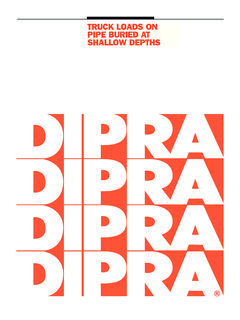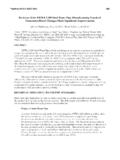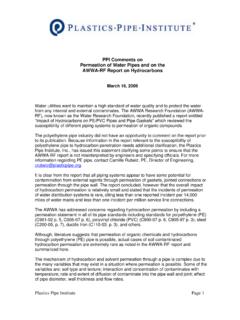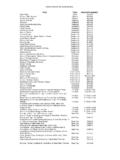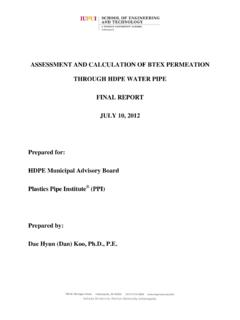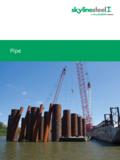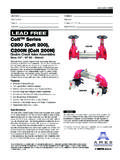Transcription of Ductile Iron Pipe vs. Steel Pipe - LMICO
1 Ductile iron PIPEVS. Steel pipe ALL pipe MATERIALS ARE NOT EQUAL: Ductile iron VS. Steel PIPEBy L. Gregg Horn, , DIPRA Director of Regional EngineersandMark R. Breslin, , DIPRA Staff EngineerWhen Ductile iron and steelpipe are bid against eachother on transmissionmain projects, owners andengineers are often inundated withinformation relating to various aspectsof these competitive materials. Thecompetition is lively, but the facts aresometimes hard to come by. Ourpurpose is to show areas where DuctileIron pipe has distinct, irrefutableadvantages over Steel pipe . Whether theconcern is engineering, installation, oroperation, an objective comparison ofthese two products shows they are notequal.
2 Ductile iron pipe s conservativedesign and ease of installation make itdecidedly better. Ductile iron PipeInternal Pressure DesignIs More ConservativeThan Steel PipePerhaps the most striking differencebetween Ductile iron and Steel pipe is therelative way their internal pressuredesigns are modeled. Only Ductile Ironpipe has a standardized design procedure(ANSI/AWWA C150 ), and theapproach in that standard is the mostconservative in the piping industry. Steelpipe design is not standardized, althoughinformation may be found in theAmerican Water Works Association sManual of Water Supply Practices, M-11, Steel pipe - A Guide for Design andInstallation, as well as in Welded SteelPipe - Steel Plate Engineering Data -Volume 3 published by the AmericanIron and Steel Institute, and manu-facturers Ductile iron and Steel pipe useversions of the Barlow hoop stressequation to model internal pressuredesign.
3 Ductile iron pipe utilizes a safetyfactor of in the design pressure,whereas, with Steel pipe , the allowablestress is limited to between 50 percentand 75 percent of the minimum yieldstrength, depending on the magnitude ofthe surge IronPressure Class DesignAccording to AWWA C150, ThicknessDesign of Ductile iron pipe , internalpressure design incorporates the workingpressure and surge pressure, which areadded together prior to applying a factor ofsafety of This is referred to as apressure class design because the surgepressure is part of the design pressurecalculation. The standard surge pressureallowance is 100 psi, which isapproximately the surge that would occurin Ductile iron pipe if the velocity of flowwere to abruptly change by two feet persecond.
4 Different surge pressures arehandled by substituting them in place ofthe standard surge pressure Ductile iron pipe (AWWA C150standard design), the hoop stress equation is:(Equation 1)t = Fs(Pw+ Ps)(D)2 S where: t= pipe net wall thick-ness, of safety ( )Pw=working pressure, psiPs=surge pressure, psiD=outside diameter, minimumyield strength of DuctileIron, psi (42,000 psi) Steel pipe InternalPressure Design ReducesSafety Factor to as Low as Steel pipe , design for workingpressure is based on 50% of the Steel yieldstrength, a factor of safety of It isimportant to note, however, that surgesare allowed to increase the stress in thepipe wall to a maximum of 75% of the wall stress to increase to75% of yield is the same as reducing thefactor of safety in design to another way.
5 If the surge pressureis less than or equal to one-half of theworking pressure, the pipe would bedesigned using working pressure only anda design stress of 50% of yield. In thiscase, a maximum surge would increase thewall stress to 75% of yield. On the otherhand, if the surge is greater than one-halfof the working pressure, the two pressuresare added and the design stress isincreased to 75% of yield. But the effect isthe same as discussed above: The factor ofsafety in design will vary from a maximumof (zero surge) to as little as (working pressure plus maximum surge).In either case, Steel pipe design allowssurges to compromise the factor of Steel pipe , where surge pressuresare less than or equal to one-half of theworking pressure, the hoop stressequation is:(Equation 2)t = (Pw)(D)2 S where: S= allowable stress, psi=50% yield strength ofsteelBut for Steel pipe where surgepressure is greater than or equal to one-half of the working pressure, the hoopstress equation becomes:(Equation 3)t = (Pw+ Ps)(D)2 S where.
6 S= allowable stress, psi=75% yield strength ofsteelComparison ofDesign ApproachesThe differences in these designapproaches lead to some very interestingcomparisons, all of which highlight thehighly conservative design of Ductile Iron23pipe. For comparative purposes, Equation3 can be used to design Ductile iron pipeas well as Steel pipe , except that DuctileIron pipe will always limit the allowablestress to 50 percent yield strength, whichcorresponds to its factor of safety of Asan example, if we are given a 48-inchtransmission main operating under aworking pressure of 150 psi but wheresurges are assumed to be 75 psi, therelative wall thickness calculations shownin Table 1 would result.
7 We will assume forthis comparison that both Ductile iron andsteel have yield strengths of 42,000 differences in the wall thicknessesare remarkable. This results from two facts: Ductile iron pipe has an outsidediameter that is typically larger thansteel pipe in the 48-inch size. Thisaccounts for a small difference in wallthickness. Second, and more importantly, steelpipe design allows wall stress to buildto 75 percent of yield (safety factor ) if surges occur. This is why inTable 1 the two Steel pipe wallthicknesses are the same althoughtheir design pressures are result here is that Ductile Ironpipe has a design pressure of 225 psi at50% yield while Steel pipe design uses150 psi at 50% yield or 225 psi at 75percent yield.
8 In either case, the result is acalculated wall thickness for Steel pipethat is 35 percent thinner than for DuctileIron pipe , even though the pipes have thesame yield what if our example assumed asurge pressure of 100 psi? The Steel pipedesign now adds the working and surgepressures and allows the hoop stress toincrease to 75 percent of yield. The resultsfor these calculations are shown in Table , the Ductile iron pipe designresults in a much more conservativeapproach because the Ductile iron designdoesn t allow surge pressures tocompromise the factor of of Design at 50% YieldIf both pipes approached internalpressure design using a total pressuredesign, the 100 psi surge allowance wouldbe added to the working pressure and thewall stress would be limited to 50% ofyield.
9 Resulting thicknesses would be asshown in Table , the percent thicker wall forDuctile iron pipe now is a function only ofthe difference in the outside materials have identical yieldstrengths and the same nominal factor ofsafety of However, Ductile iron pipe sconservative wall thickness designdoesn t stop iron pipe Design:Service and CastingAllowancesDuctile iron pipe design providesadditional allowances as part of the pipewall thickness calculation. A nominal service allowance of inches is addedto the above calculation. Additionally, acasting allowance dependent upon pipesize ( inches for 48-inch pipe ) is gives the total calculated thickness for Ductile iron pipe design and is thethickness one would use to select theappropriate pressure class.
10 Table 4summarizes the results of what happenswhen Ductile iron pipe design includes itsstandard allowances and is then comparedwith the Steel pipe examples summarizedin Tables 2 and Ductile iron pipe , Pressure Class150 (nominal thickness = in.) would beselected. Steel pipe design would in. or a standard 5 gauge ( in.)wall thickness for the Steel pipe designed to75 percent yield (a factor of safety of );this is the design that would normallybe the result for Steel pipe . If the yieldstrength were held to 50 percent (as is donefor Ductile iron pipe - a factor of safety ) the result would be in. or astandard plate thickness of 5/16th inch( in.)


